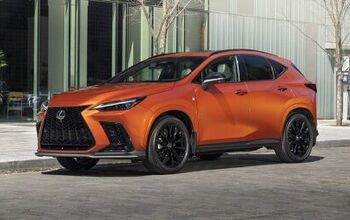Lexus NX350h Vs NX450h+ Comparison: Do You Really Need a Plug-In Hybrid?

It’s a question we get asked often: is a plug-in hybrid better than a regular hybrid? With the Lexus NX350h vs NX450h+, the answer is: it depends.
The compact Lexus NX is one of the few vehicles out there available in both regular hybrid and plug-in hybrid forms. The number of options in the luxury SUV space is fewer still. Both options offer improved fuel economy, but how they realize those gains are subtly different.
Is it ease of use and a lower price of entry you’re after? How about performance, and the promise of near-silent errand runs? There’s no wrong answer here, but it requires being honest about your luxury SUV priorities. During this year’s Automobile Journalist Association of Canada’s EcoRun 2022 event, we were able to sample both flavors of the Lexus NX back-to-back. Here’s what we found.
Get a Quote on a New Lexus NXLexus NX350h vs NX450h+: Interior and Cargo Space
NX: As you’d expect, there isn’t a lot between these two when you’re sat behind the wheel. Lexus debuted its new infotainment system in the NX last year, and the large touchscreen dictates the cockpit design, and not only because the sheer size of the 14.0-inch screen (optional on the 350h, standard on the 450h+). The new interface’s simple menus are mirrored in the cleaned-up dashboard design, and the removal of the oft-derided touchpad in the center console. A new steering wheel looks much nicer, both in its design and with the better-integrated controls. One cool feature: cars with one of the contrast-color interior options have it extend up through the center console, visually dividing the space for more of a cockpit feel.
There are a few differences, of course. Lexus offers the NX450h+ in F Sport flavor, which brings with it unique aluminum trim pieces in place of the wood and textile offerings found elsewhere in the NX lineup. Perhaps most surprising, a panoramic glass roof is optional on the 350h but unavailable on the 450h+. The PHEV gets a moonroof though, which is optional in the 350h.
Go for a full metal roof and there’s 38.3 inches (963 millimeters) of front headroom; legroom is a full 41.0 inches (1,041 mm) regardless of spec. Rear headroom ranges from 38.5 to 37.4 inches (978 to 950 mm), and rear legroom is 36.1 inches (917 mm). The front seats are typical Lexus comfy: a wide range of power adjustments ensures drivers of all sizes can get comfortable, and there’s a memory feature available. Rear seating is good, though the NX still feels a little tight compared to the likes of the BMW X3 or Genesis GV70. We’re still not sold on the electronic door releases, either.
Behind the seats, there’s 22.7 cubic feet (643 litres) of storage space, which is generous but on the lower end of the class. Folding down the rear seats expands the available space to 46.9 cu-ft (1,328 L).
SEE ALSO: Jaguar F-Type Convertible vs Lexus LC Convertible: Beauty and the BeastLexus NX350h vs NX450h+: Tech and Features
NX: Let’s get the bad news out of the way first. No matter which screen size you find inside the NX (9.8 or 14.0 inches), there won’t be a physical tuning knob. There is one for volume, however, and a pair of big dials for climate, which cleverly incorporate bits of the screen in their centers.
The rest of the Lexus Interface system is so much more impressive than its dull name suggests. The Android-based UI uses a simple, always-visible side menu, making it easy to navigate. Similarly, climate controls stay on screen, so there’s no digging in sub-menus to activate the seat heaters. Wireless Apple CarPlay and Android Auto are both present, too. A digital instrument panel provides plenty of configurable info, too.
Models with the available head-up display (HUD), like these two, go even further. The touch-sensitive steering-mounted controls operate this, with all of the sub-menus (and even user-selected favorites) visible right ahead of the driver. It takes a little getting used to, but becomes a very powerful and useful tool, with minimal distraction.
There are four USB ports on board, and an available wireless charger. Lexus’ excellent Mark Levinson sound system is also available for audiophiles—but bizarrely, only on the 350h, not 450h+. Other great optional tech includes a digital rearview mirror and a panoramic view monitor, the latter of which offers a view “through” the car to make avoiding obstacles even easier.
On the safety front, every NX comes equipped with Lexus Safety System+ 3.0, which bundles automated emergency braking, pedestrian and cyclist detection (including while turning), left-turn intersection assistance, blind-spot monitoring, lane centering, traffic sign recognition, and full-range adaptive cruise control, among other systems. These testers include rear cross-traffic alert and a parking assist as well.
SEE ALSO: 2023 Lexus RX First Drive Review: Best-Seller Gets BetterBottom Line: The NX offers buyers one of the most comprehensive tech suites in the segment, and it’s standard. There’s nothing between these two in terms of safety, but the odd omission of the Mark Levinson sound system in the PHEV means that, technically, the 350h wins this category.
Powertrain, Driving Feel, and Fuel Economy
NX350h: It was one of those gross, soggy days when we drove the NX pair, giving the Lexus compacts a chance to show how coddling they can be in less-than-ideal weather. Both offer a smooth ride and well-insulated cabin. At least until you have to dig deep into the throttle.
The NX350h runs the latest generation of the Toyota/Lexus hybrid system, which we’ve seen in everything from the Sienna minivan to the related RAV4. It’s more powerful here, with a combined system output of 240 horsepower. That makes it decently quick in a straight line: the jog to highway speed is in the low-7s. But the 2.5-liter naturally-aspirated four-cylinder sounds rough and noisy when tasked with hard acceleration. The CVT keeps the blare going, too, whereas most other luxury options use a traditional auto to keep revs low. It’s a little jarring in an otherwise well-mannered ride.
Even riding on 20-inch wheels, the NX 350h falls more on the comfort side of the spectrum. As it should, as far as we’re concerned. The steering is light and accurate, and there’s reasonable amounts of body roll. The new TNGA platform provides a stiff structure, and chops weight compared to the previous generation—which the hybrid powertrains add back in. If there’s a single word to sum up the driving experience, it’s “secure.”
Fuel economy is stellar. Even with standard AWD, the NX350h is rated at a combined 39 mpg (6.0 L/100 km). We saw slightly worse during our testing, a triple-hit combo of a hilly route, lousy weather, and almost exclusively highway driving—a known hybrid weakness—being the culprit.
NX450h+: Bad news: the PHEV doesn’t ditch that rough-sounding 2.5-liter engine. But it does pair with a more powerful rear electric motor, which sucks electrons from an equally embiggined battery pack (now lithium-ion to boot). With a combined 304 hp, this means two things: it’s quicker (6.2 seconds to 62 mph / 100 km/h) at full chat, and there’s more opportunity to let the gas engine sleep.
Be careful with the throttle and the NX450h+ will do up to 37 miles (60 km) on nothing but electricity. That’s a solid amount, especially if your daily trips don’t surpass it. Plug in at home, and the NX is back to full juice in as little as 2.5 hours. Neat.
Crucially, the driving experience isn’t much different than the other NX. Just quicker. There’s a more natural blend between one propulsion source and the other, but otherwise, the NX450h+ is familiar territory.
The plug-in powertrain does pack on over 400 lb (181 kg), so it does feel ever so slightly more hesitant turning into corners. The F Sport package does its best to negate that, with the adaptive damper system providing a smoother ride that takes the sting out of bigger bumps.
The combined fuel economy rating for the NX450h+ is 36 mpg (6.6 L/100 km); slightly worse than the regular hybrid. However, factor in the all-electric range and then you’re looking at 84 mpg-equivalent (2.8 Le/100 km). On our test route, the NX450h+ soundly beat its official scores, hitting 42.7 mpg (5.5 L/100 km).
Bottom Line: The move to the TNGA platform blesses the NX with a smooth, confident ride that rightly prioritizes comfort over sporty pretences, even in F Sport guise. The gas engine is the weak point in both, sounding uncouth in a luxury vehicle. We like the PHEV’s extra eagerness, and the ability to run on electricity alone for more than a block. That being said, it’s hard to argue with the ease-of-use and economic consistency of the 350h powertrain.
Lexus NX350h vs NX450h+: Styling
NX: With the second-generation NX touching down for 2022, Lexus’ compact SUV has cleaned up its styling. The sheetmetal is cleaner, the overhangs are shorter, and there’s more modern design cues, like the full-width taillight setup. Standard wheels measure 18 inches, though both of these testers utilize different 20-inch rolling stock.
Unless someone is literally looking at the badge on the tailgate, they’ll be hard-pressed to tell which specific drivetrain is under-hood. Between these two, the visual differences are largely a result of the F Sport package on the 450h+. In comes a more aggressive front bumper with larger air intakes, darker window trim, black side mirrors, and body-colored wheelarch extensions. The 450h+ also rides lower to the ground—something to keep in mind if you’re going to take it off-road.
Bottom Line: No matter how you spec it, the NX is now a handsome, if slightly anonymous, wedge of compact luxury SUV. Get it in one of the good colors!
SEE ALSO: 2021 Lexus LC 500 Coupe Review: Exquisite ExpressPricing and Value
NX350h: The absolute most affordable NX hybrid model is $43,850 ($52,045 CAD), which is a pretty solid deal for something so efficient. There are multiple trims to advance through from there, though Lexus keeps the F Sport options limited to the turbo 350 and the 450h+. Throw absolutely everything Lexus will allow at the NX350h—Luxury package, Mark Levinson, powered folding rear seats, pano roof, etc etc—and you’re looking at $58,545. The only options missing there are the tow hitch and premium paint.
In Canada, the trim names and bundles are all different. What’s important to know is that a loaded NX350h touches $67,595 CAD.
NX450h+: With more standard equipment and that plug-in powertrain, the NX450h+ rings in much higher, starting at $58,450 ($62,095 CAD). The trim-to-trim price difference in the US is around $7,000. Opt for the F Sport and you’ll find few options: drop all but the 6.6-kW onboard charger on, and you’ll end up at $62,655. Still no Mark Levinson, though.
In Canada, the NX450h+ is available in three flavors, with the top model ringing in at a eye-wincing $78,495 CAD.
SEE ALSO: Genesis GV70 vs BMW X3 Comparison: Compact Luxury Face-OffBottom Line: The NX350h is arguably the sweet spot of the vast NX family. It starts at barely more than the gutless NX250 AWD, and undercuts the turbo NX350. That it achieves around 50-percent better fuel economy makes it a tempting choice.
The NX450h+ is, as expected, pricier—much pricier, in fact, at the top end. But, you do have to add on extra options in the regular hybrid to match the spec. Do that, and the gap shrinks down to around four or five grand. Depending on available incentives and rebates, the plug-in can be had essentially at par with the 350h. Check your local offers.
Verdict: Lexus NX350h vs NX450h+
Like we said at the beginning, the question of Lexus NX350h vs NX450h+ comes down to priorities. If you’re regularly driving long distances, the extra cost of the 450h+ will amount to little more than some trim differences and, on the F Sport, the adaptive dampers. Don’t have easy access to a plug? The PHEV doesn’t make much sense then, either. The NX450h+’s main advantages are found in cities, where it can rely on electric power more often, and for longer, than the regular hybrid. This isn’t merely a numbers game, though: we’re talking about a luxury car, after all. For some, you can’t put a dollar figure on the ability to cruise in near-silence.
The NX350h has its own charms. It’s a surprisingly affordable option in the segment, for starters, and posts the best fuel economy figures you’ll find. It’s also a lot easier to come by than the 450h+. Not having to charge is simpler too, especially for those in condos. Lexus also allows 350h buyers to spec practically everything you can get in the Plus, and even some things you can’t.
Be honest with yourself about your use case, and which one of these Lexus NX models is right for you should become clear.
Become an AutoGuide insider. Get the latest from the automotive world first by subscribing to our newsletter here.

Kyle began his automotive obsession before he even started school, courtesy of a remote control Porsche and various LEGO sets. He later studied advertising and graphic design at Humber College, which led him to writing about cars (both real and digital). He is now a proud member of the Automobile Journalists Association of Canada (AJAC), where he was the Journalist of the Year runner-up for 2021.
More by Kyle Patrick










































Comments
Join the conversation
Sorry, yes, that has been corrected.
The answer is neither because I prefer the 2023 Outlander PHEV because it has a 3rd row.